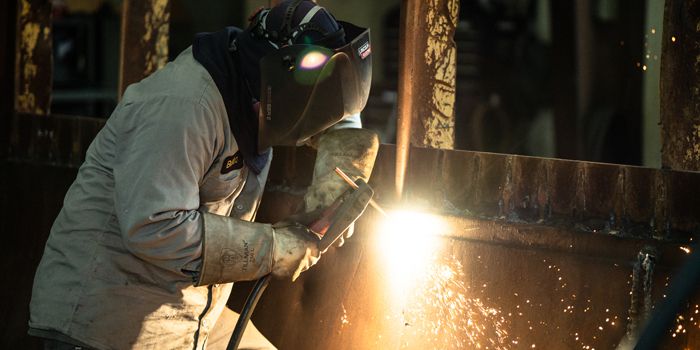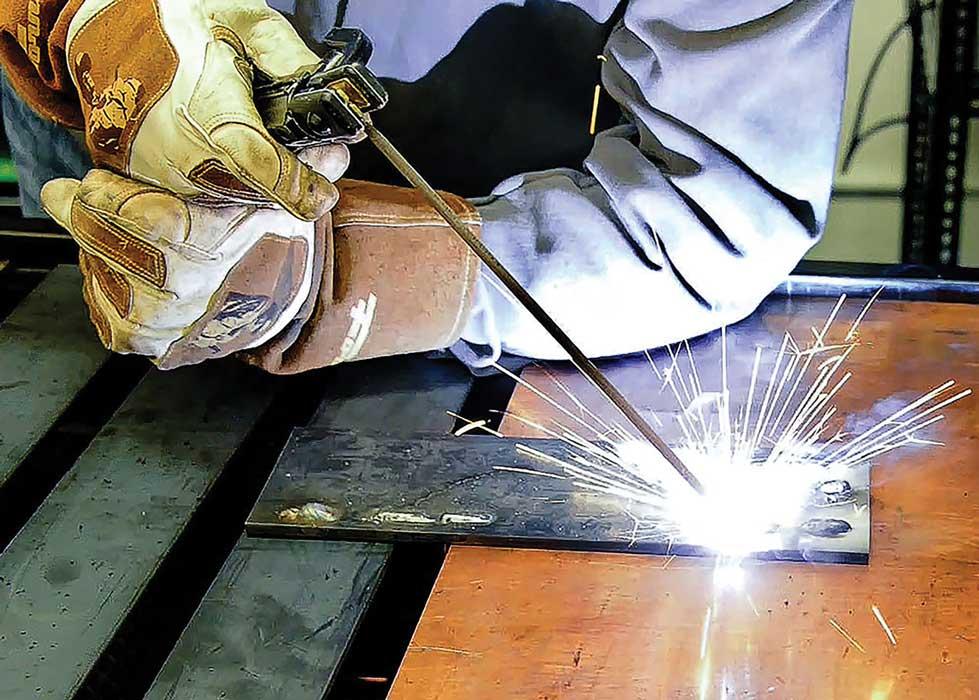Typical Welding Repair Work Issues and Exactly How to Address Them Effectively
Welding repairs frequently experience a series of issues that can endanger the stability of the end product. Usual issues include insufficient penetration, porosity, and imbalance, to name a few. Each flaw presents unique challenges that call for certain methods for resolution. Recognizing these issues is necessary for welders intending to improve their skills and end results. This discussion will explore these usual welding repair work concerns and effective approaches to resolve them.
Insufficient Infiltration
Inadequate penetration takes place when the weld metal falls short to fully fuse with the base product, leading to weak joints and possible structural failings. This concern typically stems from inadequate heat input, inaccurate electrode angle, or improper welding speed. Welders may run into inadequate infiltration due to a mistake of the essential criteria for a details product density or type. Additionally, contamination on the base material's surface can prevent reliable bonding, intensifying the problem. To attend to insufficient infiltration, welders should guarantee appropriate settings on their tools and keep a tidy job surface area. Regular evaluation of welds is suggested to recognize any type of deficiencies early, enabling prompt modifications and the avoidance of compromised structural honesty in bonded assemblies.
Porosity
Porosity is an usual defect in welded joints that shows up as tiny gas bubbles trapped within the weld metal. This defect can endanger the honesty of the weld, bring about decreased stamina and possible failing under stress and anxiety. Welding. Porosity typically emerges from contamination, wetness, or improper welding strategies, which enable gases to run away right into the liquified weld pool. To deal with porosity, welders need to assure correct surface prep work, keep a clean functioning setting, and use appropriate welding criteria. Furthermore, selecting the best filler product and shielding gas can reduce gas entrapment. Routine evaluation and testing of welds can help identify porosity early, assuring timely corrective actions are taken, consequently maintaining the high quality and reliability of the welded framework
Imbalance
Misalignment in welding can occur from various elements, including inappropriate setup and thermal development. Recognizing the origin is important for effective resolution. Several adjustment strategies are readily available to realign components and ensure structural stability.
Reasons for Misalignment
Welding imbalance typically comes from a selection of underlying issues that can endanger architectural honesty. One main cause is incorrect fit-up of components prior to welding, which can lead to gaps and uneven surface areas. Variations in thermal development during the welding procedure can likewise cause distortion, particularly if the materials being signed up with have different coefficients of expansion. Additionally, poor fixturing and securing may stop working to hold parts securely in place, leading to activity during welding. Poorly maintained devices, consisting of welding machines and tools, might present variances in the weld grain, additional adding to imbalance. Lastly, operator mistake, stemming from inadequate training or experience, can additionally play a considerable duty in developing misaligned welds.
Correction Techniques Available
Resolving imbalance effectively calls for a combination of rehabilitative techniques customized to the particular problems at hand. One typical method is using fixtures or jigs to hold elements in the correct position throughout welding, guaranteeing consistent placement. Additionally, preheating the products can help in reducing distortion and improve fit-up. For considerable imbalance, mechanical realignment strategies, such as making use of hydraulic jacks or clamps, can be employed to correct the placement before welding. Post-weld warmth therapy may also be needed to soothe anxieties brought on by imbalance. Ultimately, mindful inspection and modification throughout the arrangement stage can prevent misalignment concerns from becoming significant troubles, advertising a smoother welding process and enhancing total architectural stability.
Distortion
Distortion is an usual obstacle in welding that can occur from various aspects, consisting of uneven heating & cooling. Recognizing the reasons of distortion is vital for implementing reliable prevention methods. Addressing this concern not only enhances architectural stability however likewise improves the total quality of the weld.
Causes of Distortion
When subjected to the extreme heat of welding, products commonly undergo adjustments that can cause distortion. This sensation mostly emerges from thermal development and contraction throughout the welding process. As the weld location warms up, the product expands; upon air conditioning, it gets, which can create interior tensions. Furthermore, uneven heating across a work surface can aggravate these tensions, resulting in bending or flexing. The kind of product also plays a substantial duty; steels with differing thermal conductivity and coefficients of growth may respond in different ways, bring about unforeseeable distortions. Inadequate joint layout and inadequate fixturing can add to imbalance during welding, boosting the likelihood of distortion. Recognizing these causes is necessary for reliable welding repair work and avoidance techniques.
Avoidance Techniques
Reliable avoidance techniques for distortion throughout welding concentrate on regulating warm input and making sure proper joint style. Keeping a consistent warm input assists to lessen thermal growth and tightening, which can cause distortion. Using methods such as preheating the workpiece can additionally reduce the temperature gradient, promoting consistent home heating. Additionally, picking appropriate joint layouts, such as T-joints or lap joints, can boost security and lower tension concentrations. Carrying out appropriate fixturing to protect the work surfaces in position further aids in keeping placement throughout the welding process. Lastly, staggered welding series can distribute warmth a lot more equally, preventing localized distortion. By using these techniques, welders can significantly decrease the chance of distortion and enhance the total high quality of their welds.
Cracking
Splitting is a common problem experienced in welding repairs, often arising from different variables such as incorrect cooling rates, product option, or insufficient joint preparation. The event of fractures can significantly compromise the integrity of the weld, causing possible failings during procedure. To resolve this problem, welders need to initially examine the origin triggers, making sure that products work go to this website and suitably chosen for the particular application. Additionally, controlling the air conditioning rate during the welding procedure is essential; quick cooling can cause stress and result in cracking. Appropriate joint layout and prep work also add to lessening the danger. Carrying out these techniques can boost weld quality and sturdiness, ultimately lowering the probability of breaking in ended up weldments.

Incomplete Blend
A substantial issue in welding repair services is insufficient fusion, which takes place when the weld metal does not sufficiently bond with the base material or previous weld passes - Belgrade. This issue can lead to weaknesses in the joint, potentially compromising the honesty of the bonded structure. Variables contributing to insufficient fusion include inadequate warmth input, incorrect welding method, and contamination of the surfaces being signed up with. To resolve this concern effectively, welders must assure correct pre-weld flux core welding cleaning and surface preparation, along with change their welding parameters to accomplish adequate penetration and combination. Regular inspection throughout the welding process can also assist identify insufficient fusion early, permitting timely rehabilitative steps to improve the total top quality of the weld
Overheating
While welding repairs can improve structural stability, overheating provides a significant difficulty that can bring about product destruction. Too much warmth during welding can modify the mechanical residential properties of steels, resulting in lowered toughness, raised brittleness, and warping. This phenomenon is especially crucial in high-stress applications where structural integrity is extremely important. Determining getting too hot can entail aesthetic examinations for discoloration or distortion, as well as keeping an eye on temperature during the welding process. To minimize the threats related to getting too hot, welders need to use suitable techniques, such as managing heat input, adjusting travel speed, and making use of suitable filler products. In addition, implementing pre- and post-weld warm treatments can help recover material buildings and boost the general high quality of the repair, guaranteeing long-lasting performance and security.
Often Asked Inquiries
What Are the Common Signs of a Welding Flaw?

How Can I Examine My Welds for Top quality?
To evaluate welds for high quality, one can use aesthetic inspections, ultrasonic screening, and radiographic approaches. Each technique guarantees architectural honesty, identifies problems, and confirms adherence to specified requirements, inevitably improving the integrity of the bonded joints.
What Security Preventative Measures Should I Take While Welding?
When welding, one should focus on safety and security by putting on proper individual protective devices, ensuring appropriate ventilation, securing flammable materials away, this content keeping a clean work space, and recognizing surroundings to stop injuries and mishaps.
Can I Repair a Weld Without Remodeling the Entire Joint?
Repairing a weld without redoing the whole joint is possible, depending on the damages (Montana Mobile Welding and Repair Fabrication). Techniques such as grinding, including filler material, or using a welding procedure can successfully attend to certain flaws while preserving the bordering structure
What Equipment Are Essential for Effective Welding Fixes?
Vital tools for efficient welding repair services consist of a welding maker, wire brush, mill, safety gear, clamps, and filler materials. Each device plays an essential function in making sure high quality and security during the repair service process. Porosity commonly emerges from contamination, moisture, or incorrect welding methods, which allow gases to escape right into the liquified weld swimming pool. Inadequately maintained equipment, including welding machines and tools, may introduce incongruities in the weld bead, additional adding to misalignment. When subjected to the intense heat of welding, materials typically go through adjustments that can lead to distortion. Splitting is an usual issue experienced in welding fixings, frequently resulting from various variables such as improper air conditioning rates, material selection, or inadequate joint preparation. A considerable concern in welding repair services is incomplete fusion, which occurs when the weld metal does not adequately bond with the base material or previous weld passes.